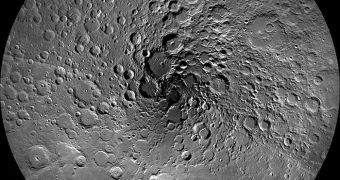About 4 billion years ago, the Moon was battered by a rain of meteorites and asteroids, most likely from the Inner Asteroids Belt. A recent analysis of the craters these impacts produced reveals that the collisions occurred at twice the speed of more ancient impact events.
Experts were very keen on learning why this happened. It's important to note here that the Moon was subject to two waves of destruction, one that occurred just after it was formed, and another about 3.8 billion years ago, called the Late Heavy Bombardment.
An analysis of craters on the lunar surface reveals that some of the newer (the term is used loosely) ones are between 30 and 40 percent larger than those produced by the first wave of space impacts.
A group of investigators from the NASA Ames Research Center (ARC) Lunar Science Institute (NLSI) recently carried out an in-depth survey of several crater clusters. Details of their work are published in a paper entitled “On the Onset of the Lunar Cataclysm as Recorded in its Ancient Crater Populations.”
The work appears in a recent issue of the esteemed scientific journal Earth and Planetary Science Letters. The primary focus of the study was the Nectaris impact basin, which is around 860 kilometers (534 miles) wide.
The team determined that the impacts in this basin were produced by space rocks traveling up to twice as fast as those that caused older craters. “This is an exciting time for lunar research with LRO and other spacecraft providing so much new data,” explains Simone Marchi.
“Collaborating with scientists of different disciplines allowed us to link these observational data to dynamical models to put new constraints on solar system history,” adds the expert, who was the lead author of the new research. Marchi is a NLSI postdoctoral fellow.
The NASA Lunar Reconnaissance Orbiter (LRO) is a spacecraft orbiting the Moon, which is capable of producing high-resolution images of its surface. Its Lunar Orbiter Laser Altimeter (LOLA) is often used for geological surveys by experts at the USGS.
Scientists with the research team believe that the space rocks which impacted the Moon during the second wave of destruction traveled so fast because they were nudged from orbit by subtle shifts in the orbits of gas giants such as Saturn and Jupiter.
“It is fascinating that the surface of our own Moon records evidence of orbital changes in Jupiter and Saturn that took place so long ago,” NLSI Director Yvonne Pendleton concludes.

 14 DAY TRIAL //
14 DAY TRIAL //